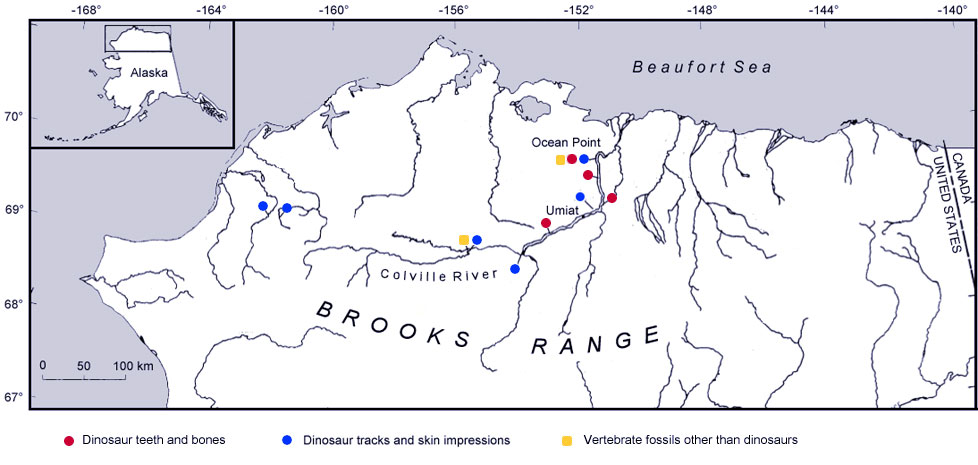The Lost World of the Arctic
| A Warm Arctic | Climate Change | Polar Light Regime | Paleo-Arctic Forests | Paleo-Arctic Fauna |
|---|
Paleo-Arctic Fauna
As well as having a rich fossil record of ancient polar forests the non-marine Cretaceous rocks of Alaska and northeastern Russia contain a wealth of animal remains including invertebrates such as insects and freshwater bivalves (Parrish et al., 1987), birds (Bryant, 1983), placental and marsupial mammals, turtles (Parrish et al., 1987), and numerous large and small dinosaurs (e.g. Brouwers et al. 1987, 1988; Godefroit et al. 2008). We only refer to a few of these here. A more comprehensive record is given in Elder et al. (1989). DinosaursIn 1961 a geologist working for Shell Oil discovered dinosaur bones in outcrops along the banks of the Colville River at Ocean Point. His name was Robert L. Liscomb and what he had found later became to be known as the 'Liscomb Bone Bed'. After remaining in storage for many years Liscomb's collection was passed to the USGS where their importance was recognised by vertebrate paleontologist Charles (Chuck) Repenning in 1983. Subsequently the bed was revisited and preliminary studies were reported by Brouwers et a1. (1987), Clemens and Allison (1985), and Davies (1987). While Liscomb's material had lain unreported other evidence of Arctic dinosaurs emerged such as footprints and skin impressions (Roehler and Stricker, 1984), but it was the discovery that Liscomb's dinosaur bones occur in what has been described subsequently as "the densest concentrations of dinosaur bones of any high latitude location in the northern or southern hemisphere" (Rich et al. 1997; 2002) that the study of these Arctic dinosaurs really took off. The veterbrate material from northern Alaska now exceeds the total of all dinosaur teeth and bones from all other published Arctic and Antarctic sites, and the remains from the Prince Creek Formation alone include bony fishes, large- and small-bodied theropods, a pachycephalosaur, ceratopsians, hypsilophodontids, hadrosaurs, and mammals (Brouwers et al., 1987; Parrish et al., 1987; Parrish and Spicer, 1988; Nelms, 1989; Currie, 1989; Clemens and Nelms, 1993; Clemens, 1994; Rich et al., 1997; Gangloff, 1998; Fiorillo and Gangloff, 2000, 2001; Fiorillo, 2004; Gangloff et al., 2005; Fiorillo, 2006, 2008a,b; Fiorillo et al., 2009, 2010, 2017). A map showing the principal localities is shown below. The age of the Prince Creek Formation sediments entombing the bones at the Liscomb bed based on pollen appears to be Maastrichtian and falls into the Wodehousia spinata zone (Fredriksen, 1990). Conrad et al. (1990) report ages of 71-68 Ma with a weighted mean of 69 Ma based on K/Ar and Ar/Ar analyses of glass shards in volcanic tuffs. Subsequent 40Ar/39Ar analyses of single crystals of sanidine yield ages slightly older, closer to the Campanian/Maastrichtian boundary (Obradovitch pers. com quoted in Fiorillo and Gangloff, 2001). For the larger forms such as the hadrosaur Edmontosaurus overwintering would have posed problems. Lack of abundant food in the form of fresh vegetation (these herbivorous animals are known to have lived in large herds) and low temperatures would have made migration to warmer latitudes where food was of higher quality and abundant, an attractive strategy. Hibernation or aestevation requires shelter of some form and this was lacking on the wet floodplains of the north Alaskan Cretaceous landscape. For small animals, including small dinosaurs, migration was not an option. With lower energy requirements they could get by with less food and the ability to burrow or shelter under leaves, twigs and branches meant that overwintering at high latitudes was possible. Dinosaurs are also known from the Cretaceous of N.E. Russia. Godefroit et al. (2008) describe isolated bones, teeth, and dinosaur eggshell fragments from the late Maastrichtian Kakanaut Formation, Koryak Region. Like in northern Alaska the hadrosaurs are well represented and are the dominant dinosaurs in late Maastrichtian deposits in northeastern Russia (Godefroit, 2004). Ankylosaurs are represented by teeth as are neoceratopsians, troodonts, dromeosaurs and tyranosaurs. Hypsilophodonts are represented by two small scalulae similar to those of Hypsilophodon foxii and Jeholosaurus shangyuanensis. One group of dinosaurs well represented in northern Alaska, but which so far have not been found at Kakanaut, are the pachycephalosaurids. Similarly absent are ectothermic reptiles such as turtles. However these too are missing from the latest Cretaceous deposits of Alaska even though they have been found in the Cenomanian there. BirdsFossil birds are rare in Cretaceous rocks of northern Alaska. However Bryant (1983) reported remains of the flightless bird Hesperornis. Bird footprints have been reported from the Lower Cantwell formation, Denali National Park (Fiorillo et al, 2010) MammalsMammals are represented by isolated teeth from what were small animals comparable in size to rats and mice. According the Clemens and Nelms (1993) the most common form appears to be a pediomyid marsupial. Multituberculates are represented by a form closely resembling Cimolodon nitidus but at least one other genus occurs. A eutherian is referable to Gypsonictops sp. The small size of these animals suggests that they would not have been able to migrate away from the area in the winter and like many similar modern mammals survived extended periods of cold and dark by hibernating, most likely in burrows or under leaf litter. ReptilesAn internal ironstone mold (steinkern) of the carapace of a freshwater turtle was discovered by Judy Parrish and Bob Spicer during fieldwork in 1985 along the Colville River. It was found in Cenomanian swamp facies of the Nanushuk Formation (then described as the Niakogon Tongue of the Nanushuk Group). The affinities of this specimen (the earliest record of a turtle above the Arctic Circle) are unclear but it has similarities to the Asian Dermatemydidae (Parrish et al. 1987). InvertebratesTrace fossils representing worm tracks and burrows are common in Cretaceous and Paleocene sediments of northern Alaska but invertebrate body fossils are also common. Inoceramids, gastropods and ammonites are abundant in marine deposits but rarer in freshwater facies. Nevetheless numerous clams occur in the Nanushuk Formation and one in particular has an interesting story to tell. Parrish et al. (1987) described an articulated specimen that bore 36 individual toothmarks distributed over both valves. They are likely to have been made by a small therapod, toothed bird or crocodilian. Insect remains are rare as is evidence of interactions between insects and plants. The leaf images in this catalogue are unusually devoid of feeding traces, galls etc. but an insect wing (possibly of a cockroach) is present in the Smiley collection from the Corwin Bluffs section and similar fossils are found in N.E. Russia. Click here for a list of invertebrate body fossils we have encountered in the course of our paleobotanical work. |
 |
|||||||
| Footprint (right hind print of a ornithopod tridactyl dinosaur) from the Nanushuk Formation, N. Alaska, described by Parrish et al. (1987). (Courtesy of Gill Mull). | ||||||||
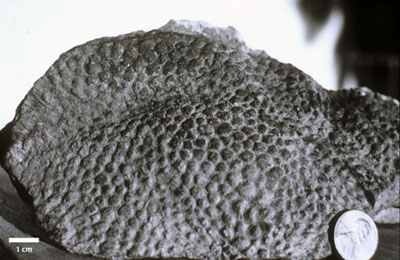 |
||||||||
| Dinosaur skin impression from the Arctic Slope, Alaska. There seems to have been no special adaptation against cold, such as fur or feathers. (Courtesy of Gill Mull). | ||||||||
 |
||||||||
| Horn core similar to those of the ceratopsians (possibly Styracosaurus albertensis or Pachyrhinosaurus) recovered from just below the Campanian/Maastrichtian boundary in the Prince Creek Formation along the Colville River (Parrish et al. 1987). | ||||||||
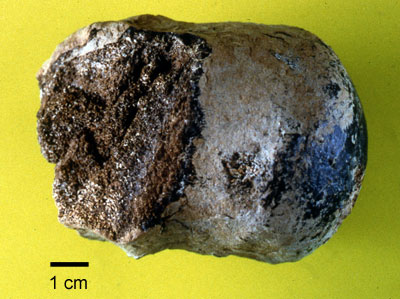 |
||||||||
| Occipital condyle of a ceratopsian from the near the Campanian/Maastrichtain boundary in the Prince Creek Formation exposed along the Colville River. The specimen is most likely to represent Anchiceratop (Parrish et al., 1987). | ||||||||
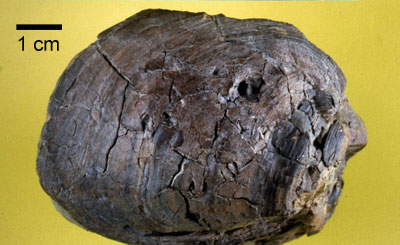 |
||||||||
| Tooth marked freshwater articulated clam from the Nanushuk Formation along the Colville River. The tooth marks could not have been made by a single bite and must have involved several bites with the clam being rotated in the predators mouth between each bite (Parrish et al. 1987). | ||||||||
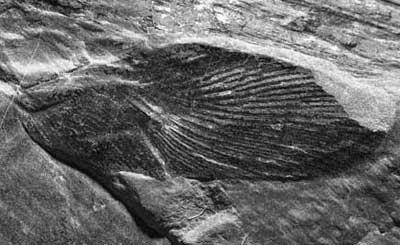 |
||||||||
| An insect (cockroach?) wing found in the Corwin Bluffs section collected by Smiley. Identical wings occur in the Cenomanian of the Okhotsk-Chukotka volcanogenic belt. | ||||||||
 |
||||||||
| Field photograph of a selection of dinosaur bones found at Ocean Point in 1986. |
